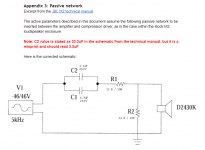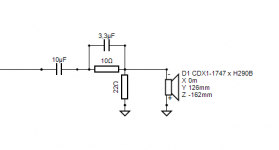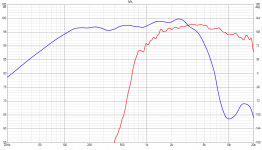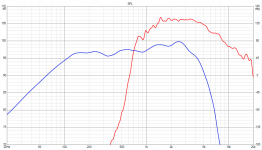Hi Art,
you are refering to another waveguide, the H290C, which is indeed an OS waveguide like the SEOS (unobtainium), the PRV/QSC (unobtainium) and the 18Sound XT1086 (this features a diffraction mouth and therefore is partly a diffraction horn, also it has some directivity errors). The Eminence H290B is an radial horn, Wayne writes the following about it:
you are refering to another waveguide, the H290C, which is indeed an OS waveguide like the SEOS (unobtainium), the PRV/QSC (unobtainium) and the 18Sound XT1086 (this features a diffraction mouth and therefore is partly a diffraction horn, also it has some directivity errors). The Eminence H290B is an radial horn, Wayne writes the following about it:
That sounded good enough for me and I ordered them a while ago. Since, I have learned some more and am willing to further optimize, because: why should I invest a lot of time in something I could do right in the beginning? But at the moment, there is no affordable OS-waveguide available from a European supplier, at least to my knowledge.The original H290 was a pretty good device ... It's what I've long considered a happy accident, in that it had very good polars and sounded great in spite of the fact that the curve of the profile was not oblate spheroidal. But the throat shape was close, and the extra expansion towards the mouth acted as a hedge against narrowing beamwidth at the bottom end. It could have used a mouth radius, but other than that, it was a pretty darn good horn.
To clarify: you're saying the H290C is very good and close, could be improved from newer knowledge, BUT that nothing improved is actually available?H290C...I ordered them a while ago. Since, I have learned some more and am willing to further optimize...But at the moment, there is no affordable OS-waveguide available...
My mistake, the Eminence H290B looks like it would have some HF "beaming" as could be expected from a horn without a diffraction slot where you can't see the driver exit off-axis. Wayne's H290C has the same mounting hole size and bolt pattern...Hi Art,
you are refering to another waveguide, the H290C...The Eminence H290B is an radial horn... why should I invest a lot of time in something I could do right in the beginning?
What is "right" may be difficult to determine in the beginning or the "end"- even though I have a preference now for constant directivity horns, many of my fondest audio memories were from radial horns that weren't.
At this point, with my HF hearing loss, "beamy" horns pointed at me, and away from my partner (she does not have the loss) might work better on average..
Last edited:
My take on this ( Paralysis through Analysis );
The Eminence H290B is not a Radial ( certainly not by my definition ).
- The H290B is a BiRadial ( in as much as each axis used a différent segment/piece lifted from 2 different exponential curves ).
As Wayne P. mentioned, when the chosen axis segments were married, one axis came pretty close to approximating an OS curve.
No matter how they are classified, they are quite decent sounding horns.
Comically, there were many put-off from buying the PRV 152i Clones because they ( P.E. ) had the temerity to include the word "exponential" in the horn's product description.
People are funny that way

The Eminence H290B is not a Radial ( certainly not by my definition ).
- The H290B is a BiRadial ( in as much as each axis used a différent segment/piece lifted from 2 different exponential curves ).
As Wayne P. mentioned, when the chosen axis segments were married, one axis came pretty close to approximating an OS curve.
No matter how they are classified, they are quite decent sounding horns.
Comically, there were many put-off from buying the PRV 152i Clones because they ( P.E. ) had the temerity to include the word "exponential" in the horn's product description.
People are funny that way
... from a European distributor.To clarify: you're saying the H290C is very good and close, could be improved from newer knowledge, BUT that nothing improved is actually available?
On the CD protective circuit: What is the benefit of two half value capacitors vs. one full. i.e. 3.3 + 4.7 vs. 8 uF? Is this a security feature in case that one cap fails, the other is still there? And the different values would also lead to one cap failing before the other? Or is it for bypass/sound reasons?
I may have found a used pair of hypex plate amps that I can afford. While I've been waiting, I figured out the following values for the analogue tweeter protection (capacitor 10 mF) and equalizer (to reduce noise). Would someone like to critizise what I have been thinking?
Attachments
- Status
- This old topic is closed. If you want to reopen this topic, contact a moderator using the "Report Post" button.
- Home
- Loudspeakers
- Multi-Way
- B&C DE-250 FRD & ZMA questions



